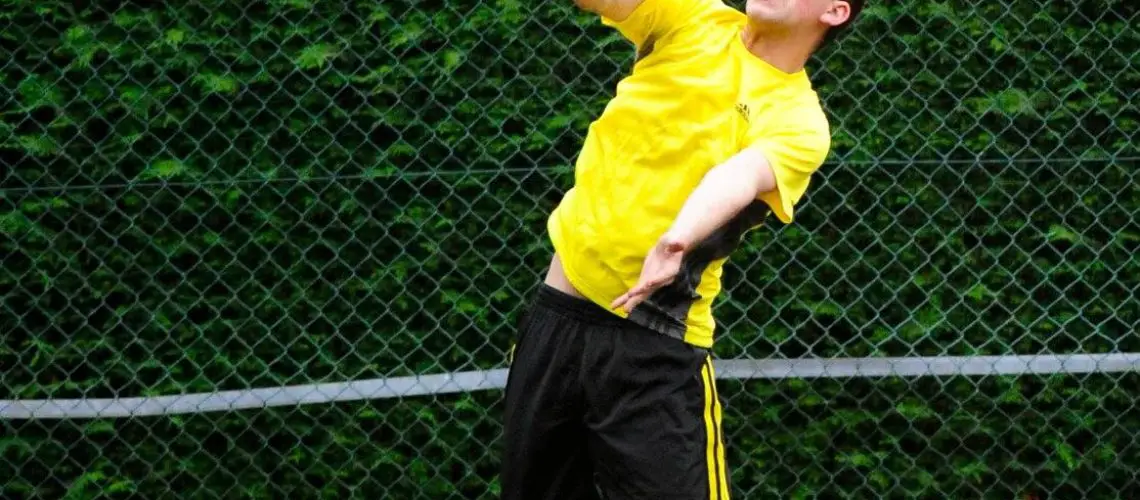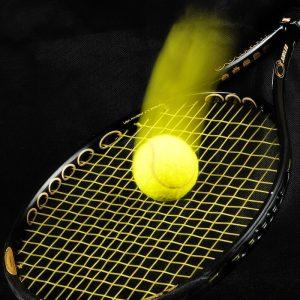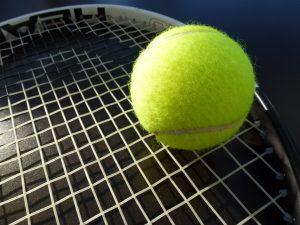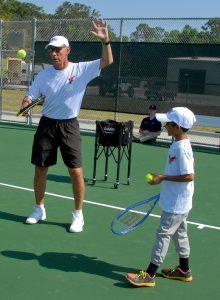We may earn money or products from the companies mentioned in this post.
Introduction

In the dynamic sport of tennis, a player’s serve is often considered their most powerful weapon Serving not only initiates each point but also sets the tone for the rest of the game It is a crucial aspect that can determine the outcome of a match In this article, we will explore the art and science behind serving in tennis, from its significance to the various types of serves employed by players
A Brief Overview of Serving a Tennis Ball
Serving in tennis involves striking the ball over the net to begin each point This action requires precision, power, and strategy The server stands behind their baseline on one side of the court and aims to hit the ball into their opponent’s service box on the other side
The Importance of Serving in Tennis
The serve holds immense importance in tennis as it offers several advantages to the server:
-
Gaining Control:
A strong serve enables players to take control of the point right from its inception By dictating play with a well-placed and well-executed serve, they can put pressure on their opponents -
Earning Free Points:
A powerful serve that is difficult to return can result in an ace or an unforced error by their opponent, awarding them free points without engaging in a rally -
Setting Up Opportunities:
A strategic serve can force opponents into uncomfortable positions on court, making it easier for servers to manipulate rallies and create opportunities for winning shots
Types of Serves Used by Players
Tennis players employ different types of serves based on their individual playing styles and objectives:
-
The Flat Serve:
This serve entails hitting the ball with speed and minimal spin, aiming to deliver a fast and direct shot that is challenging to return -
The Slice Serve:
By imparting sidespin on the ball, players can make it curve away from their opponent, making it harder to reach and control -
The Kick Serve:
Also known as the topspin serve, this technique involves hitting the ball with an upward motion, causing it to bounce high and kick off the court upon landing It can be particularly effective against opponents who struggle with high balls -
The Serve and Volley:
A more aggressive approach, this serve is followed by quickly rushing towards the net to volley the returning shot before their opponent has time to react
Objective of the Blog

The objective of this blog is to provide tennis enthusiasts with a comprehensive understanding of serving in tennis By exploring its significance and different types, readers will gain insights into how serves contribute to a player’s overall performance Whether you’re a beginner or an experienced player looking to enhance your skills, this article aims to equip you with valuable knowledge that can elevate your game on the court
The Mechanics of Serving a Tennis Ball

Serving is one of the most crucial aspects of a tennis game It sets the tone for the point and can often be a player’s most powerful weapon But serving effectively requires more than just strength and athleticism; it also requires proper technique and mechanics In this article, we will explore the key elements of serving a tennis ball, from grip to foot positioning to swing motion
Proper grip for serving
When it comes to serving in tennis, having the right grip can make all the difference Two common grips used for serving are the Eastern backhand grip and the Continental grip
The Eastern backhand grip involves placing the base knuckle of your index finger on the third bevel of your racket handle This grip allows for greater power and spin on your serve
The Continental grip, on the other hand, requires you to place your base knuckle on the second bevel of your racket handle This grip is known for its versatility and is commonly used by players who prefer slice serves or want more control over their shots
Stance and foot positioning
Your stance and foot positioning play a vital role in generating power and balance during your serve
The platform stance is a popular choice among many players In this stance, both feet are parallel to each other, shoulder-width apart This provides stability and allows for an explosive upward motion during the serve
Another option is the pinpoint stance, where one foot (usually your front foot) is positioned slightly ahead of the other This stance offers a quicker weight transfer from back to front during the serve, resulting in increased speed
Tossing the ball in preparation for the serve
The toss sets up the entire serving motion and is crucial for consistency and accuracy The height and placement of the toss can greatly impact your ability to make clean contact with the ball
When tossing the ball, aim for a height that allows you to strike it at its highest point This maximizes your chances of hitting an effective serve Additionally, try to release the ball slightly in front of your body, ensuring it’s within reach as you swing
The swing motion and contact with the ball
As you begin your swing, there are specific phases to focus on: the backswing, trophy position, racket drop phase, contact point, pronation, and follow-through
During the backswing, bring your racket behind you while maintaining a relaxed grip As you reach the trophy position (where your non-racket hand points up), prepare for the racket drop phase by bending your elbow and wrist slightly
The contact point is where you make contact with the ball Aim to hit it in front of your body at or slightly above shoulder height for optimal power and control Following contact, allow your arm to pronate (rotate inward) naturally as part of a smooth follow-through
By mastering these mechanics – from grip to foot positioning to swing motion – you can enhance your serving technique and become a formidable force on the tennis court Practice diligently and pay attention to each element individually before bringing them all together for a seamless serve
Types of Serves and Strategies

In tennis, mastering different types of serves is crucial to gain an advantage over your opponents Each serve has its own set of advantages and disadvantages, requiring specific techniques and strategies Let’s explore the various types of serves and how you can improve them
Flat Serve
The flat serve is a powerful weapon that allows you to hit the ball with maximum speed and minimal spin It can be highly effective in overpowering your opponent and setting up a strong offensive position
Advantages:
The flat serve offers great pace, making it difficult for your opponent to return the ball effectively It allows you to dictate play from the very beginning of each point
Disadvantages:
One drawback of the flat serve is its lack of spin, which makes it less forgiving if not executed perfectly If your timing or placement is off, it can result in more unforced errors
Tips to perfect flat serves:
- Focus on generating power from your legs and core rather than relying solely on arm strength
- Maintain a fluid motion throughout your service motion, ensuring a smooth transfer of energy into the ball
- Practice hitting targets consistently to improve accuracy and placement
Slice Serve
The slice serve involves imparting sidespin on the ball, causing it to curve away from your opponent It can be particularly effective when serving wide or as a change-up option during rallies
Advantages:
The slice serve creates deception by moving away from your opponent at the last moment, making it challenging for them to anticipate its direction accurately It can force them into defensive positions and open up the court for your next shot
Disadvantages:
While the slice serve offers great control and placement, it generally lacks the power of a flat or kick serve This means that opponents who are comfortable handling spin may have an easier time returning it
Techniques to improve slice serves:
- Focus on brushing the ball from the side with a slightly closed racket face to create sidespin
- Aim to hit targets close to the sideline or body, exploiting your opponent’s weaker returns
- Vary the speed and trajectory of your slice serves to keep your opponent guessing
Kick Serve (Topspin or Twist)
The kick serve, also known as topspin or twist serve, involves generating topspin on the ball, causing it to bounce high and kick away from your opponent It can be an effective weapon to neutralize aggressive returners and gain control of rallies
Advantages:
The kick serve’s ability to generate bounce and spin makes it difficult for opponents to attack aggressively It allows you to move your opponents out wide and open up opportunities for follow-up shots
Disadvantages:
One challenge with the kick serve is its complexity in mastering both power and spin concurrently Achieving consistency requires extensive practice and fine-tuning of technique
Mastering topspin or twist serve technique:
- Focus on brushing up behind the ball at contact point while maintaining a fluid motion throughout your service motion
- Aim higher over the net compared to other serves, allowing gravity and topspin to bring the ball down into the service box
- Experiment with different degrees of spin and trajectory to keep your opponents off balance
Underhand Serve
The underhand serve is a less common but useful variation, often employed as a surprise tactic or when dealing with injuries It involves hitting the ball from below waist level, typically resulting in a low and skidding bounce
When to use underhand serves:
- As a strategic change-up during matches to throw off your opponent’s rhythm
- In situations where you may be physically limited due to injury or fatigue
Proper technique for an effective underhand serve:
- Stand sideways with your non-dominant foot slightly forward for stability
- Keep your swing compact and relaxed, focusing on smooth contact with the ball
- Aim for good placement and mix up your speeds to prevent predictability
By understanding the advantages, disadvantages, and techniques associated with each type of serve, you can strategically incorporate them into your game Experimenting with different serves will not only enhance your overall performance but also keep your opponents guessing and off-balance throughout the match!
Common Serving Mistakes & Tips for Improvement

Double faults & their impact on match performance
Double faults can be a frustrating and costly mistake in tennis These occur when a player fails to get both of their serves in play, resulting in the loss of a point Double faults not only gift points to your opponent but also hurt your own confidence and momentum To improve your serve and reduce double faults, focus on consistency rather than power Practice your ball toss and timing to ensure accuracy and control over your serve Remember, it’s better to hit a safe serve that lands in than risking a powerful shot that ends up as a fault
Foot faults & understanding their implications
Foot faults occur when a player’s foot touches or crosses the baseline during the serve This is not only against the rules but also has significant consequences for your serving technique and match performance Foot faults often result from improper positioning or lack of balance while serving To avoid foot faults, pay attention to your footwork and ensure proper alignment with the baseline before initiating your serve Practicing consistent foot placement will not only help you avoid penalties but also enhance your overall serving efficiency
Addressing common errors in ball toss
The ball toss is a critical component of an effective serve, yet many players struggle with it Common errors include tossing the ball too low or too high, inconsistent placement, or lack of control over its trajectory To address these issues, focus on developing muscle memory through repetition and practice drills specifically designed for improving ball toss accuracy Work on finding the right height, placement, and spin for optimal control over your serve delivery
Increasing serving consistency
Consistency is key when it comes to serving in tennis A reliable and consistent serve puts pressure on your opponent and gives you an advantage in the match To increase serving consistency, concentrate on maintaining a smooth and repeatable motion throughout your service action Practice proper technique, including a relaxed grip, fluid arm movement, and a balanced follow-through By focusing on consistency rather than power alone, you can develop a more reliable serve that will serve you well in competitive situations
Practice drills & exercises to improve your serve
Improving your serve requires dedicated practice and specific drills to target different aspects of your technique Incorporate exercises that focus on ball toss accuracy, footwork, timing, and racquet control into your training routine For example, practicing shadow serves or using targets to aim at during serves can help enhance accuracy Working with a coach or utilizing online resources for drill ideas can provide valuable guidance as you strive to improve your serving skills
Useful Links

Tennis Rules Explained – The Basics of Tennis
Solved: When serving a tennis ball, a player hits the ball
Answered: When serving a tennis ball, the player…
General Rules: • A ball landing on any part of the line is …
Tennis rules: Know how to play
SOLVED:When serving a tennis ball, a player hits …
How to Serve a Tennis Ball (with Pictures)
When serving a tennis ball, a player hits the ball when its …
Rules of Tennis | Wanless Park Tennis
Tennis Information and Terminology
How To Hit A Tennis Ball
Tennis Serve Rules | The 5-Minute Guide
The Tennis Ball Toss: Breaking Down this Critical Aspect …
A Tennis Serve
TENNIS RULES
Hit “Up” on Every Shot
Tennis 101: How to Volley – Pro Tips – Dick’s Sporting Goods






